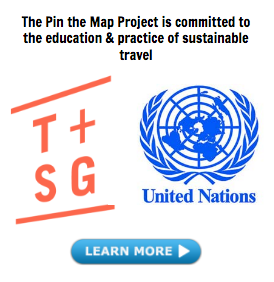If I close my eyes, I can still remember the first taste of that spoonful of freshly made dark chocolate. The subtle crunch of the sugar granules lending its sweetness, the slight bitter taste from the cocoa beans mixing with the smoothness of the whipped in milk. Moments ago I had seen all 3 ingredients come together like a choreographed dance-melting into each other while stirred by local Ngäbe women dressed in shades of vivid blue and pink. I had watched, transfixed, as one woman roasted the chocolate beans over an open fire and then passed it to another who crushed the mixture into a rich paste using a heavy, rounded rock.
It was one of those epicurean moments that are so beautiful in its simplicity that it made me wonder why I bother waiting in line for a table at overpriced Manhattan restaurants. I can remember my first macaron eaten outside Notre Dame near Paris’ Left Bank; can recall the taste of my first escargot eaten over my grandma’s granite countertop in Miami and served in a light garlic, buttery sauce; but I can’t remember a single dish from a prix fixe menu I’ve had in the past. I have perhaps ordered countless desserts in my 27 years of existence-creme brulees, cheesecakes, gelato-but few have managed to imprint their flavors in my memory the way that first bite of chocolate in Panama did.
Staying in the Bocas del Toro region, I had traveled with a group of friends and quickly found myself in that vacation cycle of sleeping, eating, exploring and drinking. Bocas del Toro was more than happy to cater to our vices with its pristine beaches, slew of island bars and growing ex-pat community of dirty blonde surfers and dreadlock-sporting hippies strumming lazily on ukuleles. After a lifetime (or a few days) that turned our group from high strung New Yorkers to coconut drinking, vintage biking island dwellers, we decided to venture off the island and head to the mainland to visit the local Ngäbe tribe. Heading as far off the beaten path as one may stray, I remember standing on an orange dirt road buying a snack from local children that can best be described as the love child of tomatoes and potatoes. It took a boat ride and a rickety bus to change my scenery from the palm tree thatched roofs of Isla Colon to the dirt-packed paths and jungle canopies of the mainland.
I had spent the morning hiking up winding trails, knocking down cocoa pods from trees and sneaking photos of sleepy sloths to finally arrive at a hilltop overlook and enjoy the fruits of my labor. If eating chocolate is said to emulate love, then that experience mixed with an uninterrupted view of the lush Panama jungle had me head over heels. Like most, I have a deep rooted love for chocolate and its alleged abilities to create smiles, alleviate pain, remedy bad days and inspire love making. I have always enjoyed the convenience with which I can pick up chocolate from my local Duane Reade but have never stopped to imagine the process by which chocolate is made. After dodging football sized cocoa pods as they fell from towering trees and after tasting the pulp of a cocoa pod, I now look differently at the candy bars stacked beneath the register at my local bodega.
Chocolate in its original form comes from cocoa beans that are nestled in large yellow or purple cocoa pods. Surprisingly, when you cut open a cocoa pod the seeds look nothing and taste nothing like chocolate. Instead, the beans are covered in a white pulp (called baba de cacao) that you can suck on for a delicious lychee-like flavor. The process by which the Ngäbe make their chocolate is simple and endearing, once again proving how it’s the littlest things in life that are sometimes the most memorable.
Our tour guide-a local cocoa farmer from the community-led us through the jungle that surrounds the unassuming and humble Ngäbe village. Wearing a sunny, yellow t-shirt and broad smile, he lovingly pointed to overlooked plants, hard-to-spot toucans and medicinal herbs that his people have come to use in their daily lives. The Oreba chocolate tour, which is entirely run by the indigenous farmers, gives all proceeds back to the Ngäbe community to benefit their education and healthcare system. It is a prime example of sustainable tourism where visitors help support the locals and leave a positive foot print on the destination they are visiting.
The highlight of the experience came when the local women whipped up that first batch of fresh chocolate for a quick, impromptu tasting. Dressed in traditional, colorful garb with her silky black hair tied up in a knot, I watched as a young woman expertly rolled the chocolate on a flattened rock and scooped it into a shard of coconut shell. I am reminded of Anthony Bourdain’s book, A Cook’s Tour, about his search for the world’s perfect meal. After roaming the chaotic markets of Vietnam, inhaling tapas at Arzak in the Basque Country and dining at Michelin starred restaurants in Napa Valley, Bourdain realized that his perfect meal was none other than one enjoyed on a beach with his wife by his side. As I looked out over the canopies of the jungle extending all around me, listened to the sounds of toucans and watched as my friends happily enjoyed this dessert; I knew this chocolate was as close to a perfect bite as I had come.
What is your most memorable food experience? Share it below!


